Create an Azure App Service assessment
As part of your migration journey to Azure, you assess your on-premises workloads to measure cloud readiness, identify risks, and estimate costs and complexity. This article shows you how to assess discovered ASP.NET/Java web apps for migration to Azure App Service, using the Azure Migrate: Discovery and assessment tool.
Note
Discovery and assessment of ASP.NET/Java web apps is now in preview. If you want to try out this feature in an existing project, please ensure that you have completed the prerequisites in this article.
Before you start
- Make sure you've created an Azure Migrate project and have the Azure Migrate: Discovery and assessment tool added.
- To create an assessment, you need to set up an Azure Migrate appliance. The appliance discovers on-premises servers, and sends metadata and performance data to Azure Migrate. The same appliance discovers ASP.NET/Java web apps running in your environment.
Azure App Service assessment overview
An Azure App Service assessment provides one sizing criteria:
| Sizing criteria | Details | Data |
|---|---|---|
| Configuration-based | Assessment that makes recommendations based on collected configuration data | The Azure App Service assessment takes only configuration data in to consideration for assessment calculation. Performance data for web apps isn't collected. |
Learn more about Azure App Service assessments.
Run an assessment
Run an assessment as follows:
In Servers, databases and web apps, select Discover, assess and migrate.
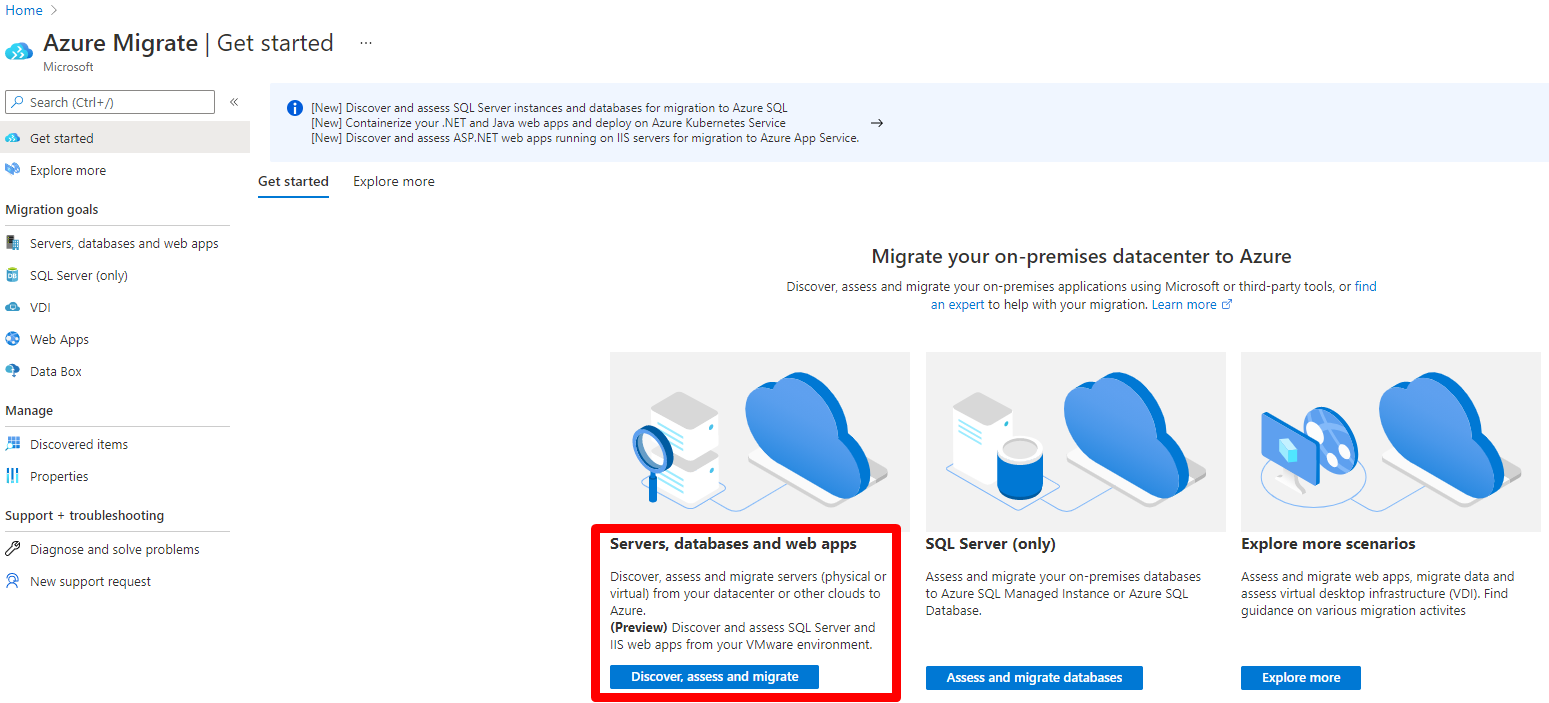
On Azure Migrate: Discovery and assessment, select Assess and choose the assessment type as Azure App Service.
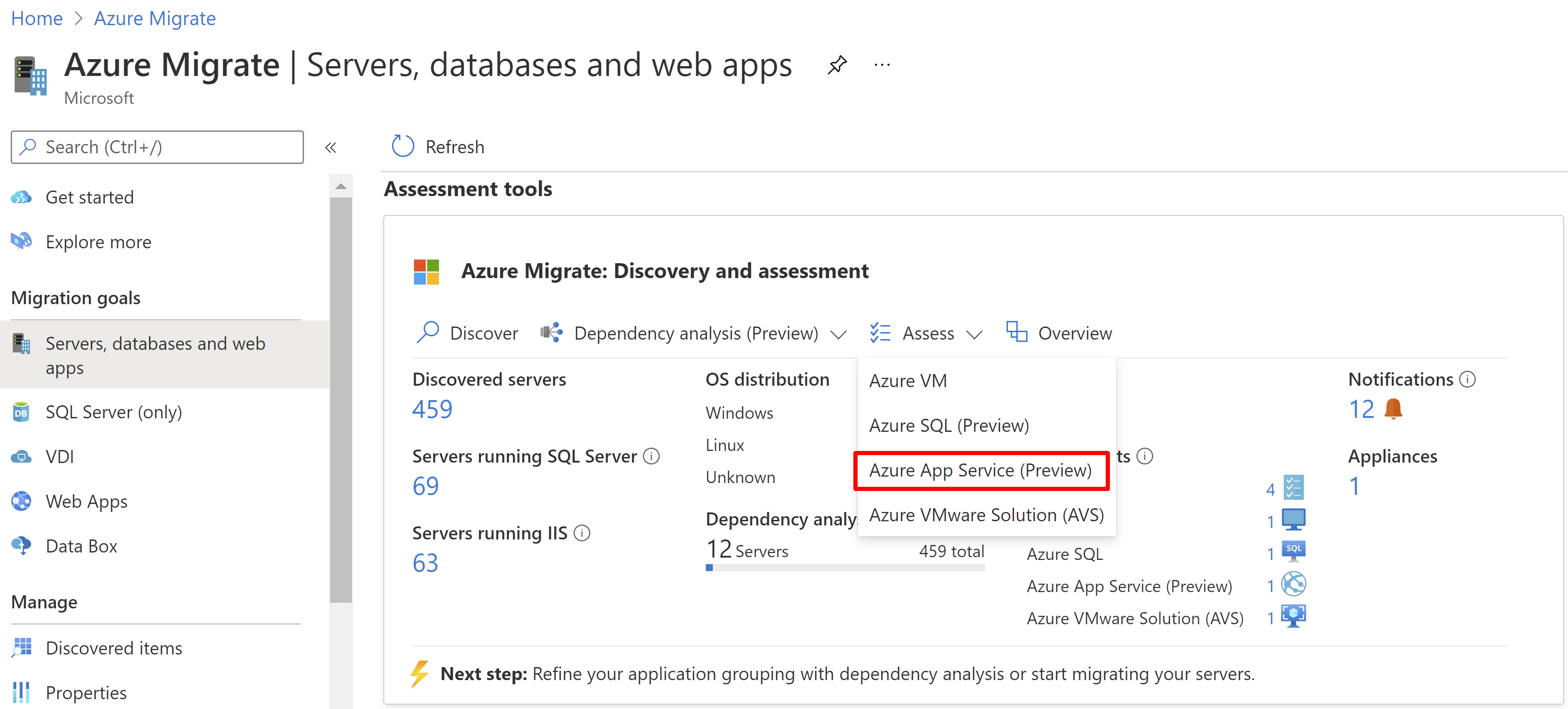
In Create assessment, you'll see the assessment type pre-selected as Azure App Service and the discovery source defaulted to Servers discovered from Azure Migrate appliance.
Select Edit to review the assessment properties.
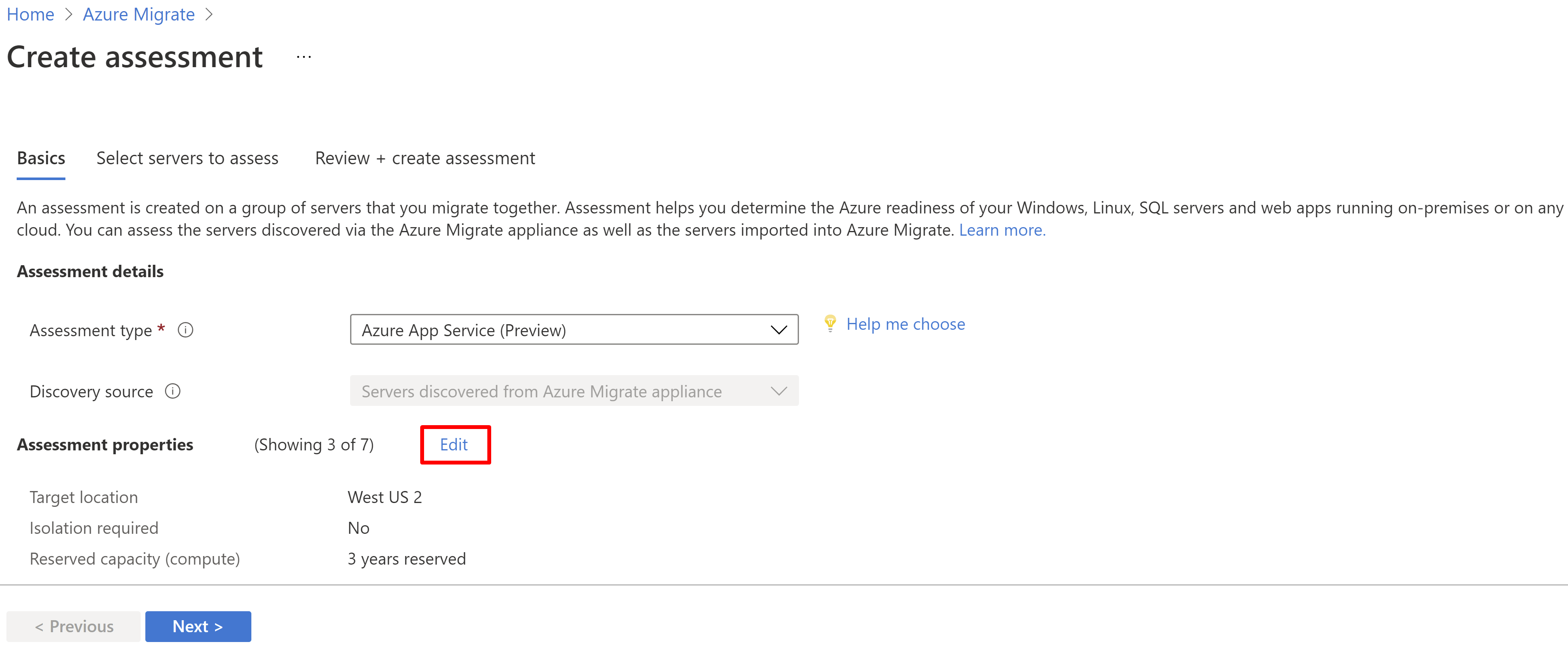
Here's what's included in Azure App Service assessment properties:
Property Details Target location The Azure region to which you want to migrate. Azure App Service configuration and cost recommendations are based on the location that you specify. Isolation required Select Yes if you want your web apps to run in a private and dedicated environment in an Azure datacenter using Dv2-series VMs. It provides faster processors, SSD storage, and double the memory to core ratio compared to Standard plans. Savings options (compute) Specify the savings option that you want the assessment to consider to help optimize your Azure compute cost.
Azure reservations (1 year or 3 year reserved) are a good option for the most consistently running resources.
Azure Savings Plan (1 year or 3 year savings plan) provide more flexibility and automated cost optimization. Ideally post migration, you could use Azure reservation and savings plan at the same time (reservation is first), but in the Azure Migrate assessments, you can only see cost estimates of 1 savings option at a time.
When you select 'None', the Azure compute cost is based on the Pay as you go rate or based on actual usage.
You need to select pay-as-you-go in offer/licensing program to be able to use Reserved Instances or Azure Savings Plan. When you select any savings option other than 'None', the 'Discount (%)' setting isn't applicable. The monthly cost estimates are calculated by multiplying 744 hours with the hourly price of the recommended SKU.Offer The Azure offer in which you're enrolled. The assessment estimates the cost for that offer. Currency The billing currency for your account. Discount (%) Any subscription-specific discounts you receive on top of the Azure offer. The default setting is 0%. EA subscription Specifies that an Enterprise Agreement (EA) subscription is used for cost estimation. Takes into account the discount applicable to the subscription.
Leave the settings for reserved instances, and discount (%) properties with their default settings.In Create assessment, select Next.
In Select servers to assess > Assessment name > specify a name for the assessment.
In Select or create a group > select Create New and specify a group name.
Select the appliance, and select the servers you want to add to the group. Select Next.
In Review + create assessment, review the assessment details, and select Create Assessment to create the group and run the assessment.
After the assessment is created, go to Servers, databases and web apps > Azure Migrate: Discovery and assessment tile and refresh the tile data by selecting the Refresh option on top of the tile. Wait for data to get refreshed.
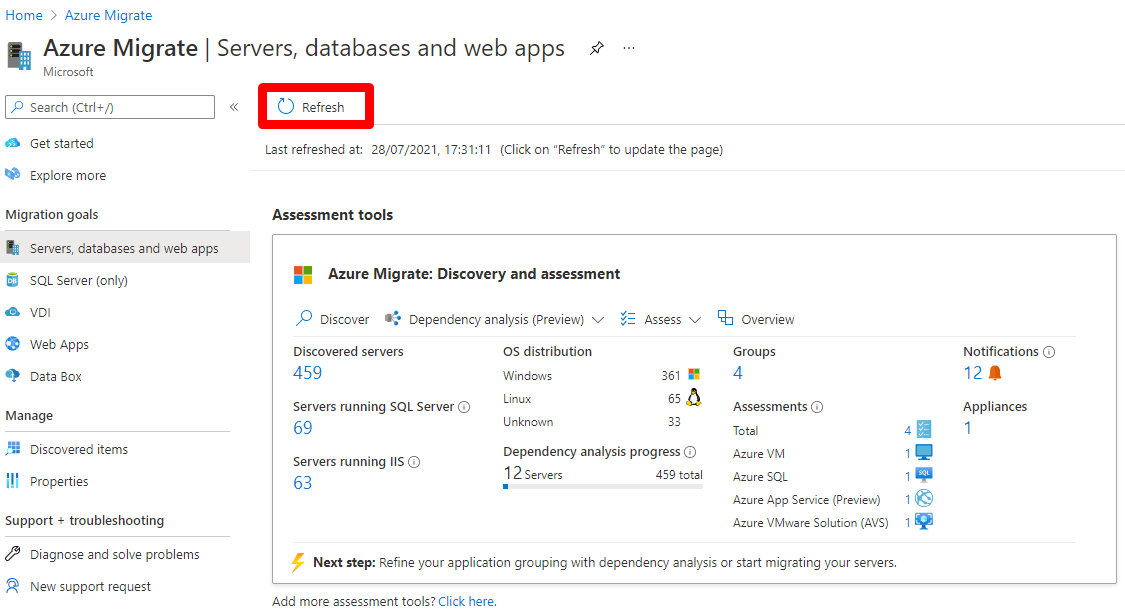
Select the number next to Azure App Service assessment.
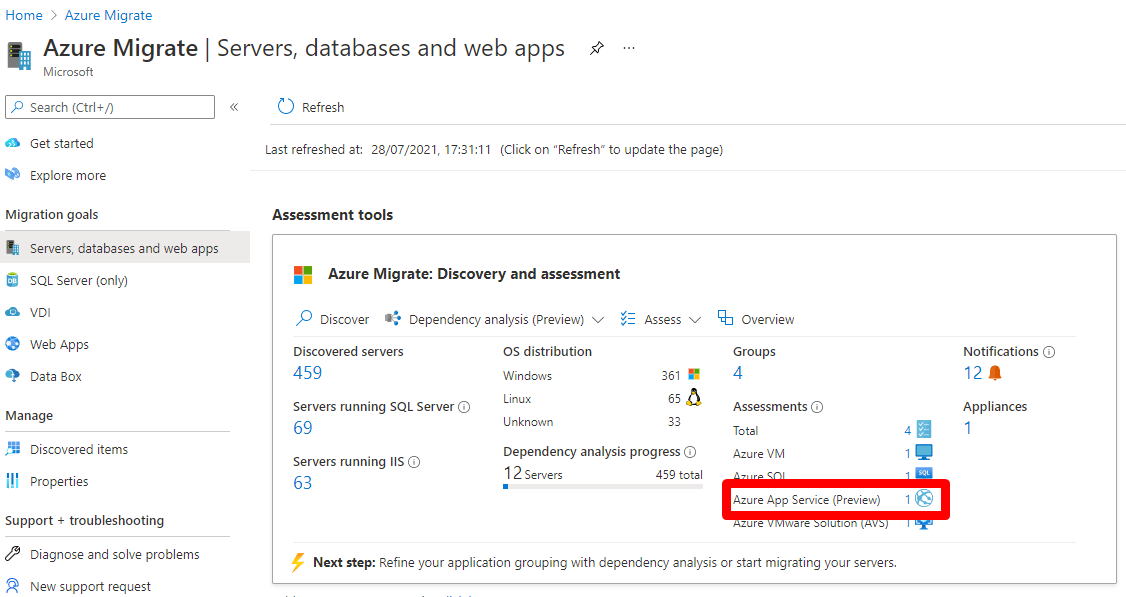
Select the assessment name that you wish to view.
Review an assessment
To view an assessment:
- In Servers, databases and web apps > Azure Migrate: Discovery and assessment, select the number next to Azure App Service assessment.
- Select the assessment name that you wish to view.

- Review the assessment summary. You can also edit the assessment properties or recalculate the assessment.
Azure App Service readiness
This card indicates the distribution of assessed web apps. You can drill down to understand details around migration issues/warnings that you can remediate before migration to Azure App Service. Learn More You can also review the recommended App Service SKU for migrating to Azure App Service.
Azure App Service cost details
An App Service plan carries a charge on the compute resources it uses.
Review readiness
- Select Azure App Service readiness.
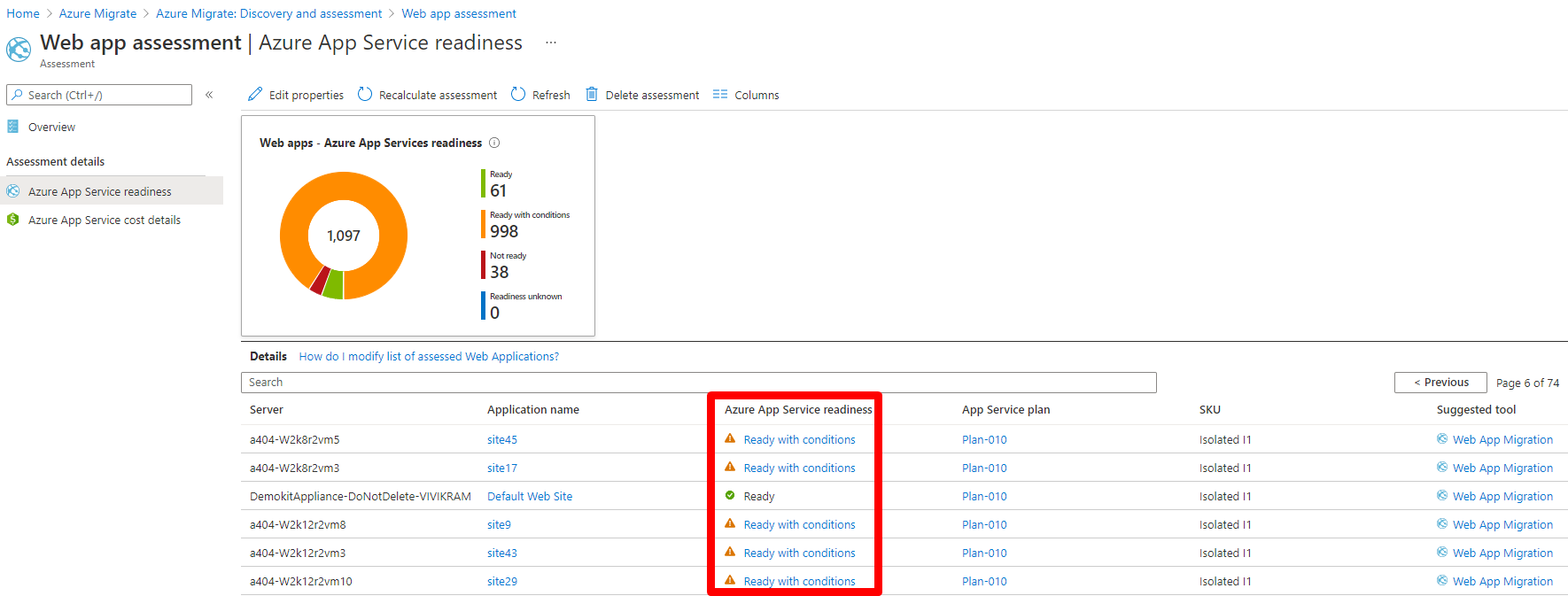
- Review Azure App Service readiness column in table, for the assessed web apps:
- If there are no compatibility issues found, the readiness is marked as Ready for the target deployment type.
- If there are non-critical compatibility issues, such as degraded or unsupported features that do not block the migration to a specific target deployment type, the readiness is marked as Ready with conditions (hyperlinked) with warning details and recommended remediation guidance.
- If there are any compatibility issues that may block the migration to a specific target deployment type, the readiness is marked as Not ready with issue details and recommended remediation guidance.
- If the discovery is still in progress or there are any discovery issues for a web app, the readiness is marked as Unknown as the assessment couldn't compute the readiness for that web app.
- Review the recommended SKU for the web apps that is determined as per the matrix below:
| Isolation required | Reserved instance | App Service plan/ SKU |
|---|---|---|
| Yes | Yes | I1 |
| Yes | No | I1 |
| No | Yes | P1v3 |
| No | No | P1v2 |
| Azure App Service readiness | Determine App Service SKU | Determine Cost estimates |
|---|---|---|
| Ready | Yes | Yes |
| Ready with conditions | Yes | Yes |
| Not ready | No | No |
| Unknown | No | No |
- Select the App Service plan hyperlink in table to see the App Service plan details such as compute resources, and other web apps that are part of the same plan.
Review cost estimates
The assessment summary shows the estimated monthly costs for hosting you web apps in App Service. In App Service, you pay charges per App Service plan and not per web app. One or more apps can be configured to run on the same computing resources (or in the same App Service plan). Whatever apps you put into this App Service plan run on these compute resources as defined by your App Service plan. To optimize cost, Azure Migrate assessment allocates multiple web apps to each recommended App Service plan. Number of web apps allocated to each plan instance is as per the table below:
| App Service plan | Web apps per App Service plan |
|---|---|
| I1 | 8 |
| P1v2 | 8 |
| P1v3 | 16 |
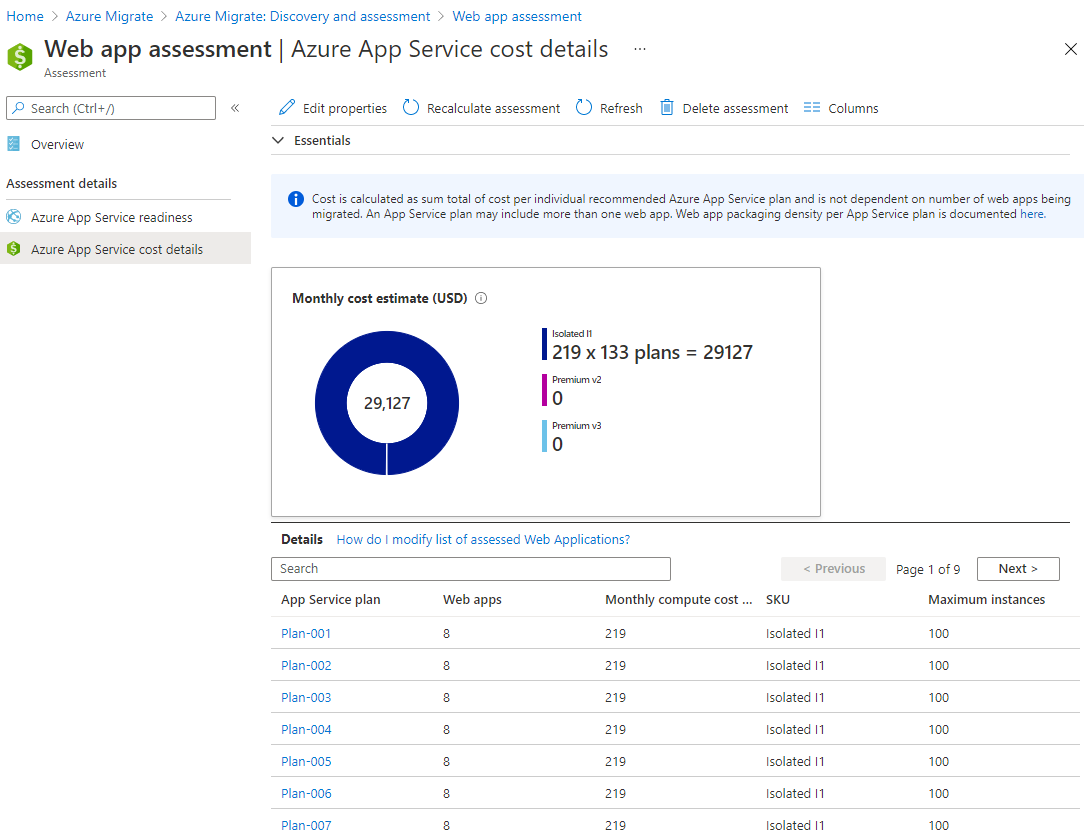
Next steps
- Learn more about how Azure App Service assessments are calculated.